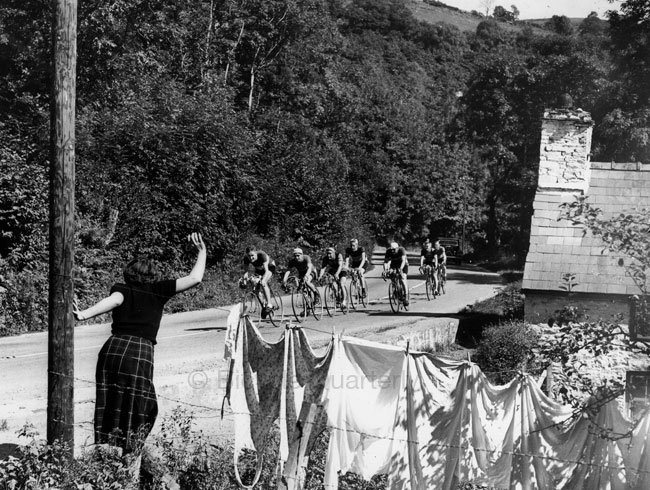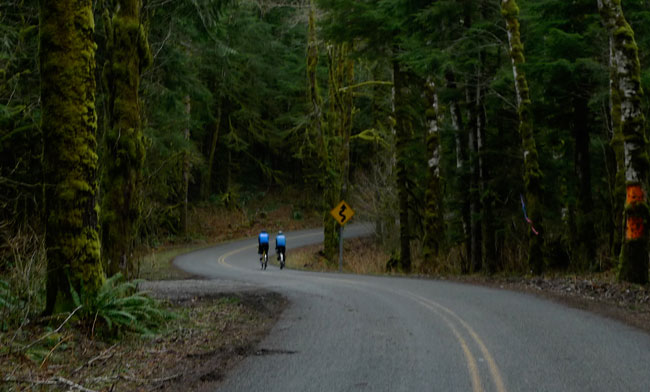Pro-Joy instead of Anti-Racing

These days, the “real-world” or “alternative” cycling world often seems to define itself by what it is not: It’s not racing. One company even made a patch that said: “Racing Sucks!”
Perhaps this sentiment is understandable, considering how much racing has dominated bike design and cycling culture in recent decades, often with negative consequences like narrow tires, poor fender clearances and a general attitude of “every ride a race.”
Even so, I prefer a positive vision.

Bicycle Quarterly is not against anything. We are in favor of the joy of cycling. The joy as we feel the wind in our faces. The joy of the bike leaning into one turn and then immediately transitioning into another. The joy of the tires singing on the road, and the bike picking up speed as we increase the pressure on the pedals. The joy of seeing the sun rise behind a mountain peak in the distance during an early-morning ride.
The joy of cycling has nothing to do with racing or un-racing. It’s about riding. Racers experience the joy of cycling as much as commuters, and everybody in between. Throwing up arbitrary divisions might make people feel better about themselves, but I prefer to share the joy with anybody who cares to ride a bike.

For me, the joy of cycling is inextricably linked with performance. Tires that glide over rough pavement, frames that get in sync with your pedal strokes, and steering geometries that make the bike follow your chosen line with precision – they all contribute to the joy of riding your bike.
Competition (although not necessarily racing) has brought us many of the advances in bicycles we enjoy today, whether lightweight frame tubing, supple tires or multiple gears. The best performance bikes are much more fun to ride than pedestrian machines that have not been optimized for speed and performance. Competition, whether it’s randonneurs trying to see how far they can ride in 24 hours, or racers climbing big mountain passes, provides a very effective test for performance. Without competition, we wouldn’t have the bikes we enjoy so much today.
Once bicycles no longer are used in competition, their performance, and with that the joy of riding them, tends to deteriorate.
Steel bikes used to be the fastest bikes, and even today, the best steel bikes still match the performance of the best carbon and titanium bikes. Unfortunately, few riders experience the joys of a truly exceptional steel bike any longer, since the performance of many steel bikes has regressed in recent decades. Manufacturers change tubing dimensions with scant consideration of how this will affect the bike’s ride and performance. Since these bikes no longer have to prove themselves in competition, their reduced performance has gone largely unnoticed. And they are less joyful to ride as a result.
In the 1930 and 1940s, many randonneurs rode wide tires in various cyclotouring competitions. Supple, fast and wide tires were offered by a variety of makers. When randonneurs switched to narrower tires, wide high-performance tires no longer were made. Until recently, the only wide tires you could buy were harsh-riding and slow.

You don’t have to go fast to enjoy the benefits of a high-performance bike. In fact, I enjoy a frame that “planes” and tires that smooth out road imperfections especially when I am just spinning along.
Making bikes that perform well and are a joy to ride takes diligence and dedication. “Don’t race!” and “Racing Sucks!” often seem to be a cheap excuses for: “We don’t want to spend the time and effort to make our bikes/tires/components faster and more enjoyable to ride.” Anti-Racing then turns into Anti-Joy. And whatever I think about racing, I cannot agree with that.

So let’s focus on the joys of cycling. Let’s see what we can learn from racers. Let’s lead by example, so the racers can learn from us as well. We all share the same goal: to have fun on our bikes.
Photo credits: Jack Taylor collection (top), Cycles Alex Singer (3rd from top).


